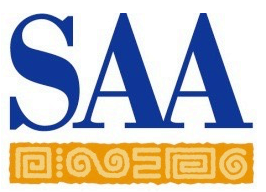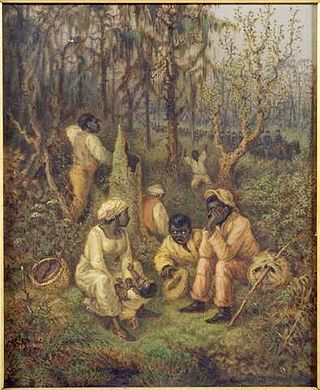Related Research Articles

Egyptology is the scientific study of ancient Egypt. The topics studied include ancient Egyptian history, language, literature, religion, architecture and art from the 5th millennium BC until the end of its native religious practices in the 4th century AD.

The American Colonization Society (ACS), initially the Society for the Colonization of Free People of Color of America, was an American organization founded in 1816 by Robert Finley to encourage and support the repatriation of freeborn people of color and emancipated slaves to the continent of Africa. It was modeled on an earlier British colonization in Africa, which had sought to resettle London's "black poor".
The Council for British Archaeology (CBA) is an educational charity established in 1944 in the UK. It works to involve people in archaeology and to promote the appreciation and care of the historic environment for the benefit of present and future generations. It achieves this by promoting research, conservation and education, and by widening access to archaeology through effective communication and participation.

Prehistoric archaeology is a subfield of archaeology, which deals specifically with artefacts, civilisations and other materials from societies that existed before any form of writing system or historical record. Often the field focuses on ages such as the Stone Age, Bronze Age and Iron Age, although it also encompasses periods such as the Neolithic. The study of prehistoric archaeology reflects the cultural concerns of modern society by showing interpretations of time between economic growth and political stability. It is related to other disciplines such as geology, biology, anthropology, historiography and palaeontology, although there are noticeable differences between the subjects they all broadly study to understand; the past, either organic or inorganic or the lives of humans. Prehistoric archaeology is also sometimes termed as anthropological archaeology because of its indirect traces with complex patterns.
Landscape archaeology, a sub-discipline of archaeology and archaeological theory, is the study of the ways in which people in the past constructed and used the environment around them. It is also known as archaeogeography. Landscape archaeology is inherently multidisciplinary in its approach to the study of culture, and is used by pre-historical, classic, and historic archaeologists. The key feature that distinguishes landscape archaeology from other archaeological approaches to sites is that there is an explicit emphasis on the sites' relationships between material culture, human alteration of land/cultural modifications to landscape, and the natural environment. The study of landscape archaeology has evolved to include how landscapes were used to create and reinforce social inequality and to announce one's social status to the community at large. The field includes with the dynamics of geohistorical objects, such as roads, walls, boundaries, trees, and land divisions.

Angel Mounds State Historic Site, an expression of the Mississippian culture, is an archaeological site managed by the Indiana State Museum and Historic Sites that includes more than 600 acres of land about 8 miles (13 km) southeast of present-day Evansville, in Vanderburgh and Warrick counties in Indiana. The large residential and agricultural community was constructed and inhabited from AD 1100 to AD 1450, and served as the political, cultural, and economic center of the Angel chiefdom. It extended within 120 miles (190 km) of the Ohio River valley to the Green River in present-day Kentucky. The town had as many as 1,000 inhabitants inside the walls at its peak, and included a complex of thirteen earthen mounds, hundreds of home sites, a palisade (stockade), and other structures.

The Chartered Institute for Archaeologists (CIfA) is a professional organisation for archaeologists working in the United Kingdom and overseas. It was founded in 1982, and at 21 July 2020 had 3,931 members overall, of whom 3,033 were accredited professionals; it also has 80 accredited organisations.
Feminist archaeology employs a feminist perspective in interpreting past societies. It often focuses on gender, but also considers gender in tandem with other factors, such as sexuality, race, or class. Feminist archaeology has critiqued the uncritical application of modern, Western norms and values to past societies. It is additionally concerned with increasing the representation of women in the discipline of archaeology, and reducing androcentric bias within the field.

African Burial Ground National Monument is a monument at Duane Street and African Burial Ground Way in the Civic Center section of Lower Manhattan, New York City. Its main building is the Ted Weiss Federal Building at 290 Broadway. The site contains the remains of more than 419 Africans buried during the late 17th and 18th centuries in a portion of what was the largest colonial-era cemetery for people of African descent, some free, most enslaved. Historians estimate there may have been as many as 10,000–20,000 burials in what was called the Negroes Burial Ground in the 18th century. The five to six acre site's excavation and study was called "the most important historic urban archaeological project in the United States." The Burial Ground site is New York's earliest known African-American cemetery; studies show an estimated 15,000 African American people were buried here.

The Archaeological Institute of America (AIA) is North America's oldest society and largest organization devoted to the world of archaeology. AIA professionals have carried out archaeological fieldwork around the world and AIA has established research centers and schools in seven countries. As of 2019, the society had more than 6,100 members and more than 100 affiliated local societies in the United States and overseas. AIA members include professional archaeologists and members of the public.

Glenn Albert Black was an American archaeologist, author, and part-time university lecturer who was among the first professional archaeologists to study prehistoric sites in Indiana continuously. Black, a pioneer and innovator in developing archaeology field research techniques, is best known for his excavation of Angel Mounds, a Mississippian community near present-day Evansville, Indiana, that he brought to national attention. Angel Mounds was designated a National Historic Landmark in 1964. Black was largely self-taught and began serious work on archaeological sites in Indiana in the 1930s, before there were many training opportunities in archaeology in the United States. He is considered to have been the first full-time professional archaeologist focusing on Indiana's ancient history, and the only professional archaeologist in the state until the 1960s. During his thirty-five-year career as an archaeologist in Indiana, Black also worked as a part-time lecturer at Indiana University Bloomington from 1944 to 1960 and conducted a field school at the Angel site during the summer months.

The Society for American Archaeology (SAA) is a professional association for the archaeology of the Americas. It was founded in 1934 and its headquarters are in based in Washington, D.C. As of 2019, it has 7,500 members. Its current president is Deborah L. Nichols. Notable past presidents include Dean R. Snow.

Community archaeology is archaeology by the people for the people. The field is also known as public archaeology. There is debate about whether the terms are interchangeable; some believe that community archaeology is but one form of public archaeology, which can include many other modes of practice, in addition to what is described here. The design, goals, involved communities, and methods in community archaeology projects vary greatly, but there are two general aspects found in all community archaeology projects. First, community archaeology involves communities "in the planning and carrying out of research projects that are of direct interest to them". Second, community archaeologists generally believe they are making an altruistic difference. Many scholars on the subject have argued that community collaboration does not have a pre-set method to follow. Although not found in every project, there are a number of recurring purposes and goals in community archaeology. Similarities are also found in different countries and regions—due to commonalities in archaeological communities, laws, institutions, and types of communities. It has also been suggested that public archaeology can be defined in a broad sense as the production and consumption of archaeological "commodities".
The Association of Women Surgeons (AWS) is a non-profit educational and professional organization founded in 1981. Now with more than 3,800 members in more than 50 different countries, AWS is one of the largest international organizations dedicated to supporting, enhancing the interaction, and facilitating the exchange of information between women surgeons at various stages in their careers, including students and trainees. The organization's mission statement reads: "To inspire, encourage, and enable women surgeons to achieve their personal and professional goals".

Archaeology or archeology is the study of human activity through the recovery and analysis of material culture. The archaeological record consists of artifacts, architecture, biofacts or ecofacts, sites, and cultural landscapes. Archaeology can be considered both a social science and a branch of the humanities. It is usually considered an independent academic discipline, but may also be classified as part of anthropology, history or geography.
The Advisory Council on Underwater Archaeology (ACUA) serves as an international advisory body on issues relating to underwater archaeology, conservation, and submerged cultural resources management. It works to educate scholars, governments, sport divers, and the public about underwater archaeology and the preservation of underwater cultural heritage. The ACUA is an independent, non-profit organization closely affiliated with the Society for Historical Archaeology (SHA). The ACUA helps the SHA Conference Committee to organize the annual SHA Conference on Historical and Underwater Archaeology and provides continuing education through workshops and panel discussions.

The Great Dismal Swamp maroons were people who inhabited the swamplands of the Great Dismal Swamp in Virginia and North Carolina after escaping enslavement. Although conditions were harsh, research suggests that thousands lived there between about 1700 and the 1860s. Harriet Beecher Stowe told the maroon people's story in her 1856 novel Dred: A Tale of the Great Dismal Swamp. The most significant research on the settlements began in 2002 with a project by Dan Sayers of American University.
The Society for Historical Archaeology (SHA) is a professional organization of scholars concerned with the archaeology of the modern world. Founded in 1967, the SHA promotes scholarly research and the dissemination of knowledge pertaining to historical archaeology. The society is specifically interested in the identification, excavation, interpretation, and conservation of sites and materials on land and underwater. It is the largest such organization in the world and the third-largest anthropological organization in the United States.
Theresa A. Singleton is an American archaeologist and writer who focuses on the archaeology of African Americans, the African diaspora, and slavery in the United States. She is a leading archaeologist applying comparative approaches to the study of slavery in the Americas. Singleton has been involved in the excavation of slave residences in the southern United States and in the Caribbean. She is a professor of anthropology at Syracuse University, and serves as a curator for the National Museum of Natural History.
Kathleen A. Deagan is an American archaeologist who primarily focuses on excavations in Florida and the Caribbean. Known for her historic archaeology which uncovered the colonial past of La Florida, and work in St. Augustine, she has received multiple awards and honors, including the Award of Merit in 1992 and the J. C. Harrington Award in 2004, both bestowed by the Society for Historical Archaeology.
References
- 1 2 "Society of Black Archaeologists newsletter". Vol. 1, no. 1. Society of Black Archaeologists. March 2019.
- ↑ "SBA: About us". Society of Black Archaeologists. Retrieved 7 March 2019.